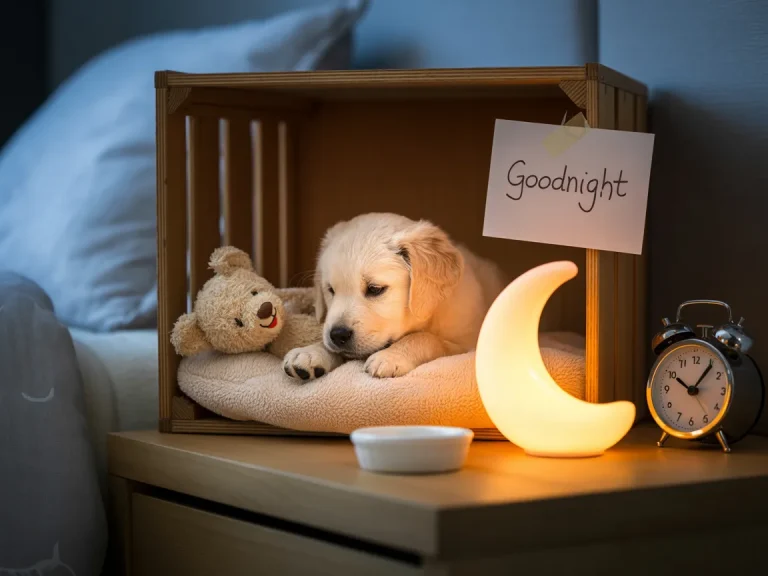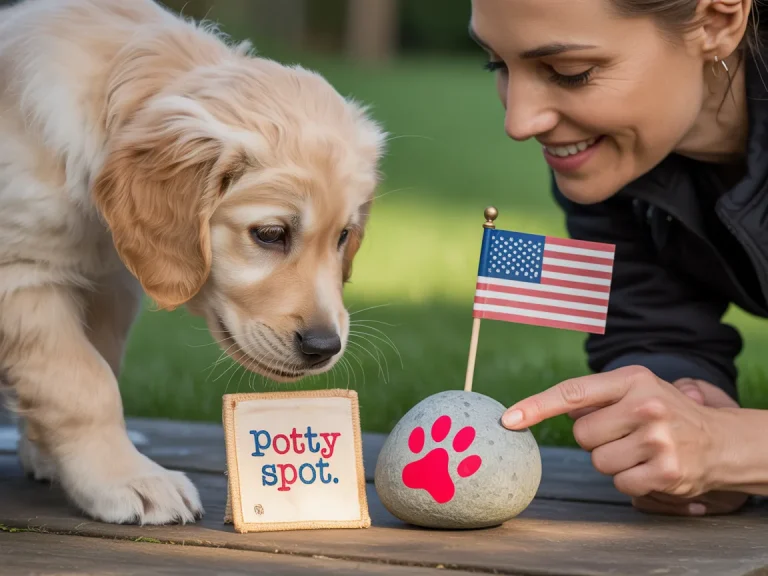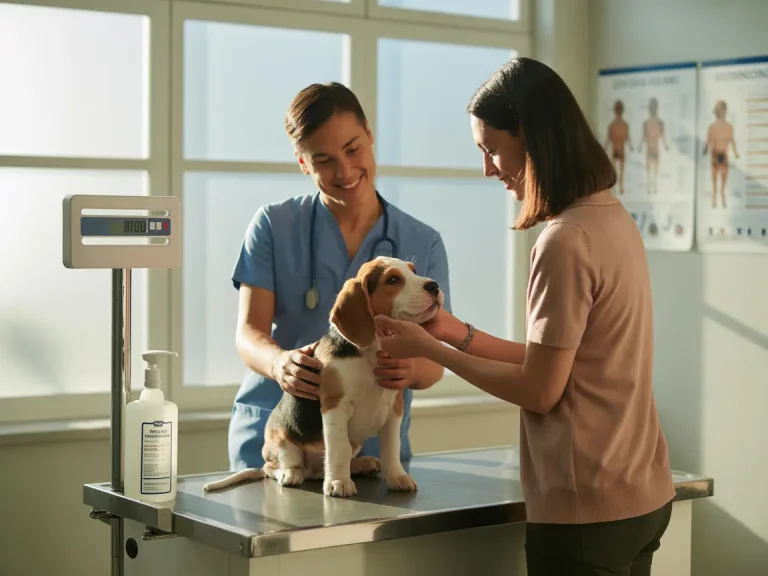Puppies experience the world primarily through their mouths, noses, and unbounded feet. Thoughtfully chosen play keeps those senses busy, protects carpets and chair legs from becoming chew targets, and lays the groundwork for confident adulthood. Interactive sessions also cement the human–dog bond, teaching little learners that great things happen when they look to you for guidance.
Even the flashiest squeaker loses appeal if it never changes. Prevent “toy fatigue” by rotating toys and puzzle games every few days and by storing extras out of sight. A small dog toy basket in the living room, paired with a larger labeled dog toy box in a closet, makes swapping effortless. With organization handled, dive into the seven ideas below—each designed to develop coordination, confidence, and calmness while satisfying natural instincts.
1. Soft-Crinkle Treasure Blanket
For brand-new noses and wobbly paws, a crinkle blanket is a gentle “first adventure.” Stitch two layers of cozy fleece together with a few clean cellophane sheets tucked inside, then add a couple of flap pockets on top and hide a few bits of kibble. It’s soft enough to mouth, noisy enough to spark curiosity, and simple enough to feel safe.
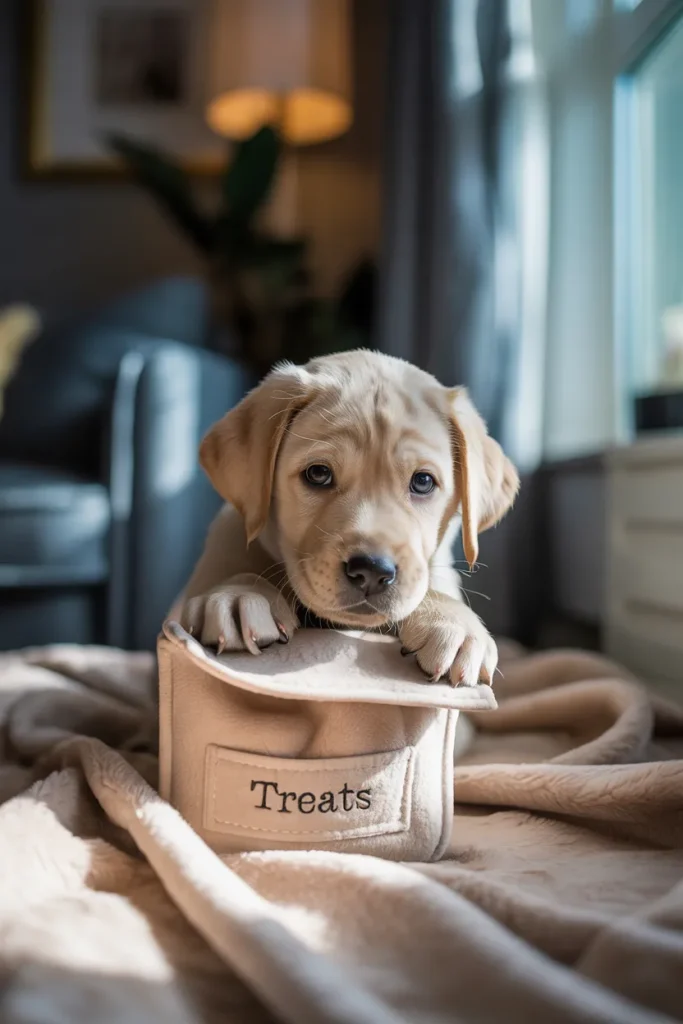
Shift the treats after every wash so your pup never solves it the same way twice. If you crochet, keep stitches snug so tiny teeth don’t snag, and when playtime’s done, fold the blanket and drop it in the toy basket—easy for small paws to tug out later for a comfort snuggle.
2. DIY Cardboard Castle Maze
Have an empty appliance box? You’ve got a pop-up puppy labyrinth. Cut a few doorways, add a dead end or two, and leave a “treasure chamber” in the back with a favorite plush or a scatter of kibble. Rearrange the inside walls each week so the scent map stays new—like swapping the levels in a video game your dog can actually win.
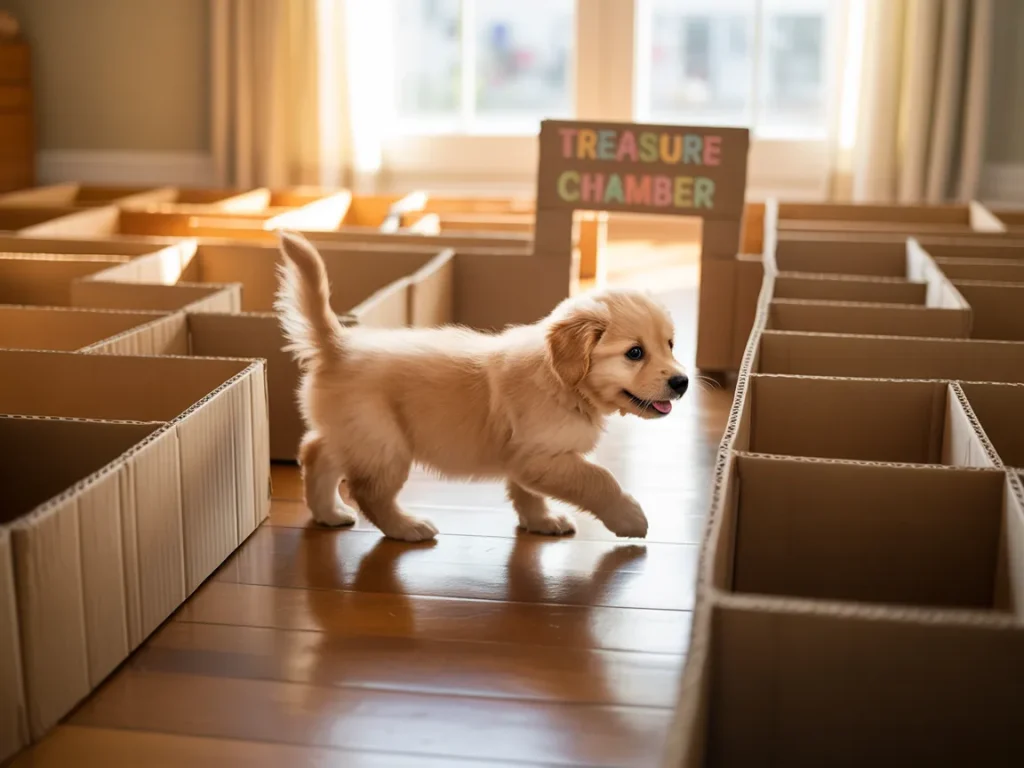
Sneak in training while you play: pair the journey with cues like “tunnel,” “left,” and “back.” Cardboard is cheap, recyclable, and easy to store—slide the panels flat behind a cabinet. Before you toss worn pieces, slice them into strips for future enrichment projects. That’s enrichment and planet-kindness in one go.
Mini-story: My own goofball, Miso, once marched into a cul-de-sac, glanced back like, “Uh, GPS recalculating?” He sniffed, pivoted, and found the prize—tail helicoptering the whole way.
3. Frozen Yogurt Rope Lollipop
Teething is hard work, and cold helps. Braid three cotton fabric strips, knot both ends, soak the middle in plain yogurt blended with a bit of banana, spiral it on parchment, and freeze for about two hours. Serve on a wipe-clean mat and let the chill do its magic on sore gums.

Got a power chewer? Thread the braid through a silicone donut ring, or swap in denim for tougher fibers. Rotate a few ropes through the freezer so there’s always a fresh one waiting; a quick rinse and refreeze turns yesterday’s favorite into today’s “new” treat—and saves your wallet too.
4. Interactive Treat-Slide Ball
Imagine a tiny pinball machine your puppy can bat around with nose and paws. A treat-slide ball lets you tweak the puzzle as your dog gets smarter—choose one with adjustable baffles, start with an easy opening for quick wins, then tighten things up as timing and paw-eye coordination grow. It keeps brains buzzing and bodies moving without turning your living room into a racetrack.
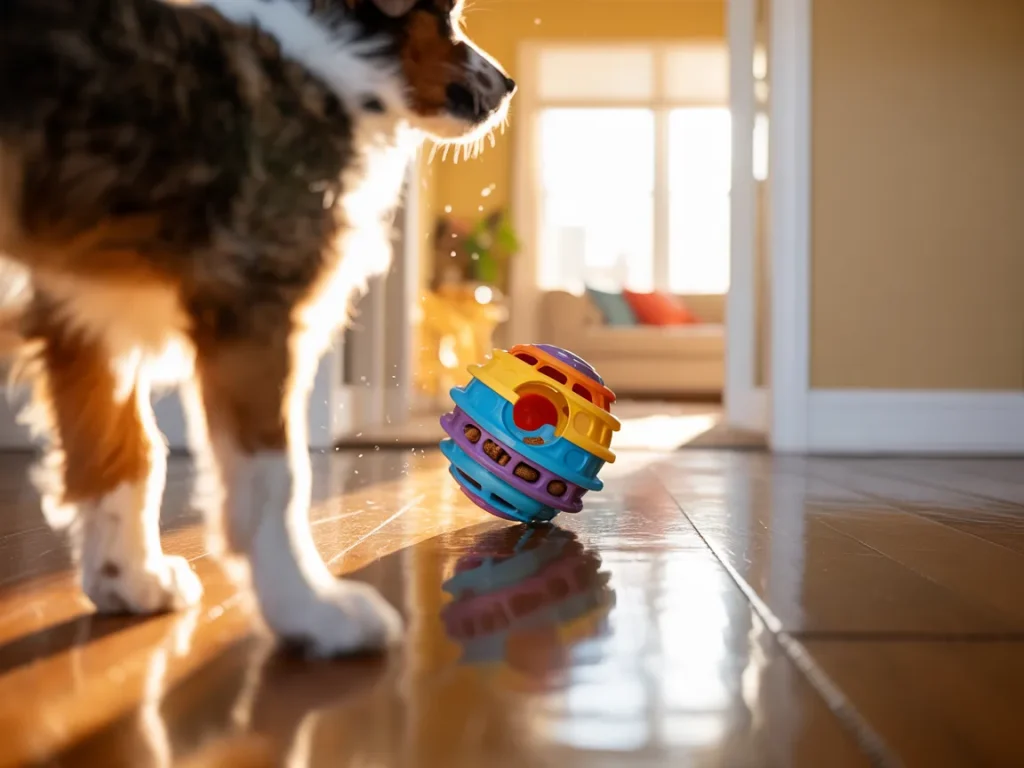
Enrichment hack
Tuck the clean, dry ball in a zip bag with a couple fresh rosemary sprigs between sessions—the gentle scent makes an old toy feel new without extra calories. When your pup levels up, swap kibble for light, air-puffed treats to boost the rattle and excitement. Store the ball in your toy box between games so it doesn’t roll around and frustrate a still-learning puppy.
5. Tug-of-Textures Ring
Think of this as a tasting flight for teeth. Braid or weave three materials—soft fleece, classic cotton rope, and a strip of bicycle inner tube—into a sturdy circle. Each texture asks for a different bite pressure, teaching self-control while making tug feel like a new game every time. It’s big enough for two-handed play and great for building polite manners around high-value toys.

Mini-story: Two littermates I worked with used to “share” the ring—one on fleece, one on rubber—like kids splitting a pretzel at the park. Zero squabbles, all smiles.
Safety note
Give the ring a quick check after each game and retire any frayed spot before it turns into floss. Hang it on a low hook so tug starts only when you offer it—your cue, your rules. Multi-dog home? Make two rings and run short group-tug rounds that burn energy and teach fair play faster than solo fetch.
6. Pop-Up Garden Snuffle Box
Grab a shallow plastic bin, punch six holes in the lid, and dress each opening with a square of artificial turf and a few felt “flowers.” Sprinkle kibble beneath half the blossoms, snap the lid tight, and let your gardener go to work. It’s a tidy, portable snuffle garden—similar to the snuffle mats many trainers love—that turns ordinary mealtime into a scent-driven scavenger hunt.
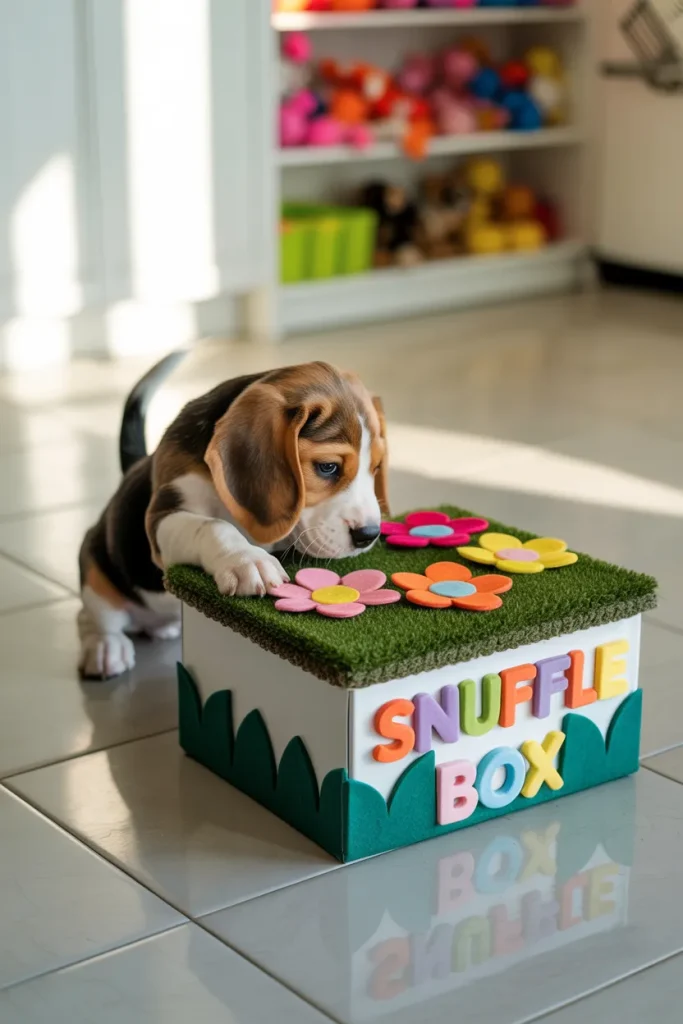
Why it works
Sniffing, pawing, and gentle nudging tap into a puppy’s natural foraging instincts, building focus and calm. When the easy hunts become old news, plug an empty hole with a rolled sock or hide a small surprise toy in one chamber for a little plot twist. Cleanup is simple: shake crumbs into the trash, wipe the lid, and slide the box back onto your storage shelf.
7. DIY Bubble-Chase Game
Bubbles turn your living room into a tiny carnival. Mix two cups of water with a tablespoon of glycerin and a quick splash of low-sodium chicken broth, then blow clusters low to the ground. Your puppy will track, pounce, and pop like a kid chasing soap planets—great for coordination and confidence, and easy on your space. If you prefer a ready-made option, the AKC notes there are dog-safe bubbles made for pets. Wipe little faces afterward to clear any residue and keep those curious eyes comfy.
Mini-story: The first time I tried this with a pint-sized whirlwind named Pip, he froze, squinted at a drifting bubble, and then—boop!—tapped it with his nose. Ten seconds later he was pogo-sticking around the rug like a fuzzball on springs, then proudly flopped down as if he’d herded the whole sky.
Game variations
Switch up your blowing style—rapid bursts, then a single slow floater—to build tracking skills and impulse control. Thread the bubble stream through an agility tunnel so they learn to zip through and “find” the bubbles on the other side. And at dusk, grab a basic battery wand with LEDs for glowing bubbles; it’s the budget version of those fancy night-play toys, and your pup won’t know the difference.
Conclusion
Intentional play is the quiet architect of a calm, confident adult dog. Rotate a few DIY toys, sprinkle in simple scent hunts, and keep the gear tidy so it feels new each time. Whether you’re hiding “treasure” in a cardboard castle or chasing shimmering bubbles under the porch light, you’re building trust, bite control, coordination—and a shared language that says, “We’ve got this, together.” Pay attention to what your puppy loves, nudge the challenge as they grow, and enjoy the joyful, messy magic of puppyhood.
Disclaimer: This article is for informational purposes only and does not constitute professional veterinary advice. Always consult a licensed veterinarian or certified dog trainer regarding the specific needs and health of your dog.



